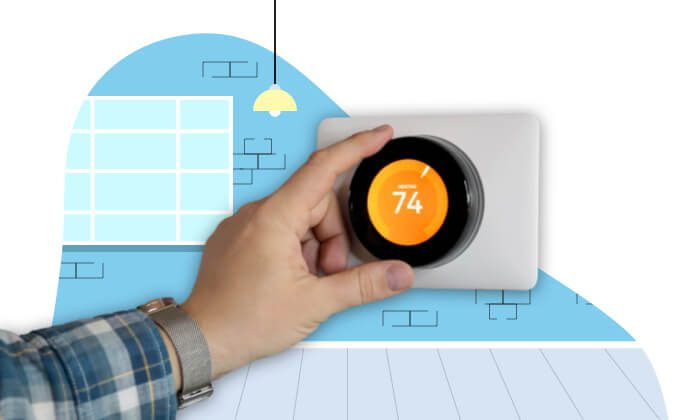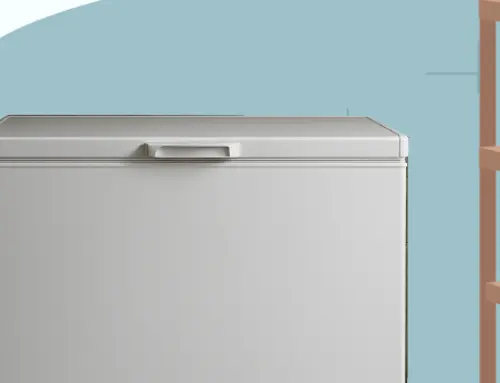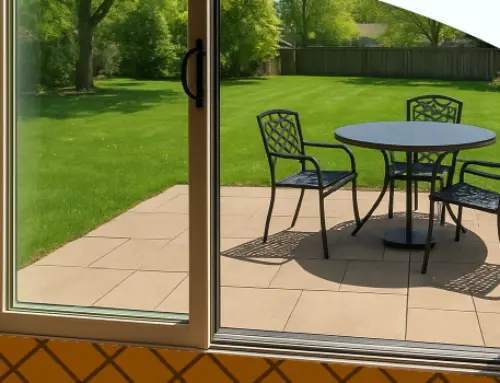Ideal Thermostat Temperature Settings for Summer & Winter 2025
by Tyler Castle
17.1 min read

If you live in an area with seasonal weather, then you might be familiar with the struggle of finding the “right” thermostat temperature — especially if you live with other people who have different opinions on what the “best” temperature is.
Determining the right temperature where you feel comfortable and can keep your energy bills low can be a challenge; but it is definitely worth the effort. According to the U.S. Department of Energy (DoE), you can “save as much as 10% a year on heating and cooling by simply turning your thermostat back 7°-10°F for 8 hours a day from its normal setting.”
ENERGY STAR, the DoE and U.S. Environmental Protection Agency (EPA) energy efficiency program, estimates that homeowners can save about $180 a year by properly setting their programmable thermostats to match and maintain those settings.
So let’s settle any debates with an overview of the recommended “ideal” temperatures for the summer and winter months, plus additional considerations for children, pets and plants.
What Your Air Conditioner Can – and Cannot – Do
Before diving into the preferred thermostat settings for winter and summer, let's discuss air conditioners and why they're important to maintaining thermostat settings. Air conditioners are designed to create a comfortable indoor environment, but they have specific capabilities and limitations. Let's dive into these specifics and how they relate to your home's temperature control.
What Your Air Conditioner Can Do
Your air conditioner can cool your air. An air conditioner's main job is to lower the indoor temperature to match your desired setting by removing heat from the air in your home. Air conditioners work most efficiently within a reasonable temperature range.
Air conditioners work to control humidity. AC systems naturally reduce humidity levels by condensing moisture as they cool the air in your home. This moisture control not only helps regulate the temperature in your home, but it helps prevent mold growth contributing to your overall health.
In the same way, air conditioners can improve air quality. Many air conditioners include filters that remove dust, allergens, and pollutants from the circulating air. Some advanced systems even include air purifiers for additional health benefits.
Many modern air conditioners can operate automatically. These air conditioners can be programmed or set to auto mode, adjusting cooling based on room conditions to save energy.
What Your Air Conditioner Cannot Do
Air conditioning units cannot provide instant cooling. Like most home appliances, AC units take time to cool a space, especially if the temperature difference is significant or the system is underpowered. Switching your air conditioning temperature frequently can lead to wear and tear on your system and damage its efficiency.
These units cannot operate efficiently if poorly maintained. Clogged filters, dirty coils, or refrigerant issues reduce cooling performance and increase energy use.
Air conditioning units are also not equipped to heat your home. Unless it's a heat pump system, a standard air conditioner is not designed to provide heating. When it comes to finding the ideal thermostat setting for winter, you'll need to rely on your heating system instead.
It's also important to note that air conditioners cannot eliminate extreme humidity. While AC systems control moisture to a degree, excessive humidity may require a dedicated dehumidifier.
Recommended Thermostat Temperature for Summer
According to the DoE, when you're at home during the day in the summer you'll want to find a balance between 70-78 degrees. The lower end of 70 degrees is the ideal summer temperature for comfort, while 78 degrees is ideal for energy savings while staying comfortable.
Your level of comfort will also be affected by humidity levels, which can make it feel hotter inside your house and will force air conditioning units to work harder in removing moisture from the air. For example, if you're in a drier climate, you can shoot for the lower end of around 70 degrees. However, if you're in a humid area or are experiencing a heat wave, try getting by at the upper range of 78 degrees.
At night, ENERGY STAR recommends making a 4 degree higher adjustment during sleep. If you're looking for the most energy savings at night, set a temperature of around 82 degrees.
When you're leaving the house, ENERGY STAR recommends raising the temperature by around 7 degrees to around 85-88 degrees. As the interior temperature of the house rises to match the outside temperature, you'll lose less cool air to the environment so your system won't need to work as hard. Reset the temperature back to the 70-78 degree range when you get home.
Recommended Temperature and Thermostat Setting for Summer
| Best Summer Thermostat Temperature for Comfort | Best Summer Thermostat Temperature for Savings | |
|---|---|---|
| At home during the day | 70° Fahrenheit | 78° Fahrenheit |
| At night while sleeping | 74° Fahrenheit | 82° Fahrenheit |
| While away from the house | 77° Fahrenheit | 85° Fahrenheit |
Energy saver tip — Don't worry about working your furnace or AC "harder" when you return by setting your temperatures to different levels while you're out or asleep — they'll work at the same efficiency regardless. However, when you get home, don't set the temperature higher or lower than the recommended settings in an effort to speed up the heating or cooling process. According to the DOE, that assumption doesn't actually work. Plus, the unnecessary heating or cooling could end up costing you more.
What Temperature Should You Set Your Thermostat When on Vacation in Summer?
While you're on a vacation in the summer, setting your thermostat to a range of 80 to 85° Fahrenheit allows your air conditioner to run occasionally, helping to control humidity levels.
This prevents excessive moisture buildup, which can lead to mold and mildew, while also avoiding the strain of cooling down a significantly overheated house upon your return. If you have pets or plants at home, consider their specific needs—certain pets and delicate plants may require a slightly cooler setting
Recommended Thermostat Temperatures for Winter
When you're active at home during the day in the winter months, the DoE recommends setting the thermostat temperature between 68-70 degrees. The higher end is more comfortable, while the lower end of 68 degrees will provide you with more energy savings.
At night, avoid the temptation to raise the thermostat higher as the outside temperatures drop. If you're feeling a little chilly at night, put on slippers, some extra comfortable layers of clothing and grab an extra blanket.
When you go to bed, you want to follow the same ENERGY STAR adjustment of 4 degrees, this time dropping the temperature down to between 64-66 degrees. Not only does this save even more on heating and electricity, the cooler temperature can aid in your quality of sleep.
When you're away from home, setback your thermostat by 8 degrees to drop the temperature of your house to around 60-62 degrees. Just like what happens in the summer, as the temperature in the house gets closer to the outside temperature, you'll start to lose less heat, which means your furnace won't need to work as hard.
Recommended Thermostat Setting for Winter
| Best Winter Thermostat Temperature for Comfort | Best Winter Thermostat Temperature for Savings | |
|---|---|---|
| At home during the day | 70° Fahrenheit | 68° Fahrenheit |
| At night while sleeping | 66° Fahrenheit | 64° Fahrenheit |
| While away from the house | 62° Fahrenheit | 60° Fahrenheit |
What Temperature Should You Set Your Thermostat When on Vacation in Winter?
You should set your thermostat settings to no lower than 55 degrees while you're on vacation in the winter. Maintaining a minimum indoor temperature of 55°F ensures that the warmth is sufficient to prevent these issues, even in colder areas of the home like basements. Additionally, keeping the temperature at this level reduces the chance of excessive moisture buildup, which can lead to mold growth—a common problem in cool, damp environments.
When the temperature inside your home drops too low, there's a risk of water freezing in your pipes, which can cause them to burst and lead to costly repairs. Similarly, appliances that rely on water can freeze and get damaged if the temperature in your home is too low.
Recommended Thermostat Settings for Spring and Fall
Setting your thermostat can be more challenging during spring and fall because the weather changes a lot. Some days you might need heating, while on others, you might need cooling. To handle this, you can program both a maximum temperature for cooling and a minimum for heating into your programable thermostat to keep your home comfy while saving energy.
Warmer Days:
- Set your thermostat to 78°F when you're home during the day.
- Raise it to 86°F if you're not at home.
Cooler Days:
- Keep it at 68°F when you're home and awake.
- Lower it to 65°F when sleeping, and to 60°F if you're away.
Modern thermostats often have an "Auto" mode, which lets you set a temperature range so your system switches between heating and cooling as needed. This range is called the "deadband," and it's the buffer zone where the system doesn't run. This approach helps maintain a comfortable indoor temperature while saving energy by reducing unnecessary heating or cooling.
Eco Friendly Thermostat Temperature Settings
Eco friendly temps are also wallet friendly, so you can take comfort that you're saving money and helping to protect the environment. 68 degrees in the winter and 78 degrees in the summer may feel a bit extreme, but they're at the range where the temperature will still feel comfortable while also being energy efficient.
The most important adjustment you need to note is to set the temperature lower in the winter and higher in the summer when you're not in the house. As the interior temperature of your house gets closer to the temperature outside, the transfer of energy slows down. That means lower interior temps in the winter result in less heat lost to the outside environment and vice versa for the summer.
If you're ever unsure about what's an eco-friendly range for temperature, check your thermostat's display. Modern smart thermostats will often show an 'eco' or 'leaf' icon when the temperature is set where it should be.
Additional Ideal Thermostat Temperature Settings for the Home
Everyone has different tolerances and comfort levels, so while these are the recommended ideals based on the general population, your own comfort may differ. Also, those ranges are for human adults, and there are a few considerations if you have pets, children or just really need a good night's sleep.
- Ideal temp with a baby in the house — Babies are more susceptible to heat and cold, so aim for between 68-72 degrees throughout the year to keep your child comfortable.
- Ideal temp with pets in the house — Most cats and dogs will be comfortable between 64-78 degrees, as they have natural ways to regulate their body temperature. However, consider factors like coat type, size, age and weight of your pets and adjust accordingly. If you have fish or reptiles, set the recommended temperatures for their aquarium or terrarium to keep them safe.
- Ideal temp for houseplants — Most plants will be perfectly fine between 60-75 degrees. If you're leaving your home for extended periods of time, try to ensure that temps don't go below 50 degrees in the winter or above 85 degrees in the summer.
- Ideal temp for restful sleep — According to the Sleep Foundation, if you want to prioritize a good night's sleep above all else, set a thermostat temperature between 60 and 67 degrees. That's noticeably lower than the recommended eco-friendly summer temperatures that are in the high 70s to low 80s. If you want to avoid setting your thermostat that low in the summer months, consider a few other cooling techniques:
- Open the window at night to let in cooler air
- Have a standing fan in the room to move air
- Use summer-friendly light sheets instead of blankets
| Babies | Pets | Plants | ||
|---|---|---|---|---|
| Ideal Temperature Ranges | 68° – 70° Fahrenheit | 64° – 78° Fahrenheit | 60° – 75° Fahrenheit |
How to Discover Your Personal Thermostat Settings
Each home will differ when it comes to the "ideal" thermostat settings and temperatures. Finding the right thermostat settings for your home ensures both comfort and energy efficiency. Here's how you can determine the best temperatures for your needs:
- Understand General Recommendations: The ideal thermostat settings for winter start at around 68°F when at home and awake. When you turn in for the night, lower your thermostat settings by 4–8°F while sleeping or away. The ideal thermostat setting for summer usually begins around 78°F while at home, raising it by a few degrees when you're out.
- Adjust for Comfort: Spend a few days experimenting with slightly higher or lower settings to see what feels best for you and your family. Pay attention to your comfort during sleep, daily activities, and while away from home.
- Factor in Energy Costs: Test how small adjustments affect your energy bill. Even changing your thermostat by 1–4 degrees can lead to savings without sacrificing comfort. It can also be helpful to use tools or apps provided by smart thermostats to track energy usage and to adjust your settings from there depending on your energy-saving goals.
- Consider Humidity: In humid climates, cooler settings might feel more comfortable. In dry areas, slightly warmer temperatures may work just as well.
- Use Scheduling Features: Program your thermostat to match your routine. Set it to lower or raise temperatures automatically during times when you're asleep or out of the house.
- Test with a Smart Thermostat: Many smart thermostats offer insights and recommendations based on your behavior and energy use. They can suggest ideal settings tailored to your habits and this can give you insight onto what your personal thermostat setting is.
- Keep Seasonal Changes in Mind: Reevaluate your settings with the changing seasons. Spring and fall may require different adjustments than winter or summer.
Following these steps can help you find your ideal thermostat setting for better comfort and home efficiency. Remember, finding the right settings might take some trial and error, but the long-term benefits—like reduced energy bills and a comfortable living environment—are well worth the effort!
Can You Set a Thermostat to Turn on at Certain Temperature?
You can set your thermostat to turn on at a certain temperature! Most thermostats (mostly smart thermostats) are designed to activate your heating or cooling system when the indoor temperature deviates from your set preference. Here's how they work:
- Temperature Sensing: Thermostats monitor the current room temperature using sensors like bimetallic strips or electronic components.
- Comparison: The device compares the sensed temperature to your desired setting.
- Activation: If there's a difference, the thermostat signals your HVAC system to heat or cool the space until the set temperature is achieved.
Programmable and smart thermostats enhance this functionality by allowing you to set specific temperatures for different times and days, optimizing comfort and energy efficiency.
How Smart Thermostats Work
Smart thermostats are designed to take the guesswork out of adjusting your thermostat settings.
Smart thermostats use sensors and algorithms to learn your routine and adjust the temperatures in your home automatically for comfort and efficiency.
Smart thermostats can even connect to Wi-Fi, letting you control it through a smartphone app from anywhere.
As another bonus, these units can automatically adjusts temperatures based on your location. For example, you can program your thermostat to start heating up your home on your way home from work so you can step into a toasty abode on your arrival!
Most thermostats also offer insights into energy usage and offers tips on how to save more energy in your home. Lastly, most smart thermostats come with safety features that maintain temperatures to prevent issues like frozen pipes or overheating and remind you when your HVAC system needs upkeep, ensuring efficiency.
What Happens When the Room Temperature Is Lower Than the Thermostat Setting?
When the room temperature is lower than the thermostat setting, the thermostat triggers the heating system to warm the space. Here's what happens step-by-step:
- Temperature Detection: The thermostat senses that the room is colder than the desired temperature.
- Signal to Heating System: The thermostat sends a signal (or closes an electrical circuit in mechanical models) to activate the heating system.
- Heating Process: The heating system (e.g., furnace, heat pump) starts running, producing heat to warm the room. It continues heating until the room temperature matches the thermostat setting.
- System Shut-off: Once the target temperature is reached, the thermostat stops the signal, and the heating system turns off.
Additional Tips for Energy Efficiency
Constantly setting your thermostat can be a chore, plus there's likely to be times when you simply forget. Installing a programmable or smart thermostat can help automatically set the temperatures so you don't have to. You can even program smart thermostats to turn on and off based on your schedule, the current weather and when a certain number of people are in your home. Some models will also provide insights about your home energy pattern usage and send reminders on how to conserve energy.
Beyond these recommended temperature ranges, here are some other tips for managing your thermostat, plus how to regulate the transfer of heat within your home:
- Blackout curtains are great not only for keeping your bedroom dark, but they can also keep warm air trapped in your room during the winter and keep the sun's heat out of your room in the summer.
- Have a ceiling fan? Not only can it help cool off a room in the summer with the counterclockwise downward draft, but it can also keep your space warmer in the winter by spinning clockwise to draw cool air up and force warmer air down.
- The ideal thermostat location is in your home near the center of the house on an interior wall. If you're installing a thermostat, keep in mind which rooms people will use most as they are the ones where the temperature will need to be the most comfortable.
- To keep your thermostat reading the correct home temperature, avoid placing it near any heat sources, such as a furnace or fireplace. You'll also want to avoid placing it near the following areas:
- Any wall that takes direct sunlight
- Next to air vents
- Near doors, skylights or windows
- In your kitchen
- In hallways
Following these tips and using the recommended ideal thermostat settings will not only save you money on your heating and electrical bills, you can take comfort in knowing that you're doing your part to reduce your carbon footprint. Looking to do even more for the environment through your electricity or heating plans? Explore our Earth-Friendly Electricity and Earth-Friendly Gas home plans to see how you can help the economy now and the planet later.
Heating and Cooling FAQs
What if I have a heat pump system?
According to the DoE, when heat pumps are in cooling mode, they act like air conditioners, so turning up the thermostat in summer can save energy and money. However, in winter, turning down the thermostat can cause the heat pump to operate inefficiently, canceling out any energy or cost savings. If you have a heat pump or are thinking of installing one, check with the manufacturer as some newer models come with specially designed programmable thermostats to allow for changing temperature ranges.
What if I have steam heat or radiant floor heating?
The slower response time of steam heating and radiant floor heating systems can make temperature setbacks less efficient for steam heat and radiant flooring systems. However, some thermostats can track the performance of your heating system to determine when to turn it on in order to achieve comfortable temperatures at your programmed time.
Why are these the recommended temperatures?
The closer your interior temperature is to the outside, the more efficient your heating and cooling systems will be. These recommended settings are on the range of what feels comfortable while allowing your home to retain heat for longer during the winter and stay cooler during summer months.
What else can I do to reduce my electricity bill?
If you're interested in other simple steps you can take to help reduce your electricity bill, see our Santanna Simplicity blog post on more ways to save.
Does a thermostat close when the temperature drops?
Yes, a thermostat can "close" the circuit to your system when the temperature drops, depending on its design and function. Closing the thermostat circuit allows electrical power to flow to the heating system, which then generates heat to warm the space. This ensures the temperature stays within the comfortable range you've set.
Tyler is an experienced energy professional, having worked for Santanna Energy Services, for the past four years. He is passionate about renewable energy and believes that diversifying the energy grid is the key to a sustainable future. Tyler is dedicated to supplying consumers with the best possible energy solutions and works diligently to make sure that Santanna can deliver the highest quality service.







